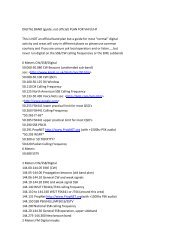Create successful ePaper yourself
Turn your PDF publications into a flip-book with our unique Google optimized e-Paper software.
2. Hardware Interface Setup<br />
If your computer is already setup for using one of the other <strong>PSK</strong>31 programs, then you should be in<br />
business. All the soundcard levels and serial port connections should work okay without readjustment.<br />
If this is a new system, then a bit more work is required. An interface from your PC soundcard to<br />
your radio is required. Unfortunately, the Soundcard was not designed as a radio interface and this is the<br />
trickiest part of <strong>PSK</strong>31 setup. Not all soundcards have the same inputs and outputs. Few radios have the<br />
same connector and signal pinouts, and so the <strong>PSK</strong>31 operator must be a little creative and dust off the<br />
soldering iron, buy a few connectors, and other assorted parts.<br />
The basic setup is shown here. The serial port PTT control is optional. One can also use the radio<br />
VOX for control or manually activate the transmitter.<br />
PC<br />
with<br />
Soundcard<br />
Soundcard<br />
Audio IN<br />
2.1. Sound Card / Radio Interface<br />
Soundcard<br />
Audio OUT<br />
7/27/01 Moe Wheatley, AE4JY 5<br />
Radio Receive<br />
Audio OUT<br />
Radio Xmit<br />
Audio IN<br />
Optional PTT Control<br />
Most soundcards that work under Windows should work okay with Win<strong>PSK</strong>. It needs to be a 16 bit<br />
type with preferably a "line IN" jack and perhaps a "line OUT" jack as well. The 16 bits refers to the audio<br />
resolution and NOT the PC bus type which can be ISA, PCI, USB, etc. as long as it is supported by<br />
Windows. The most expensive sound card is not always the best in terms of audio quality. Many $10<br />
soundcards have better audio specs than the expensive "do everything" soundcards.<br />
First lets look at the radio receive audio to soundcard connection. Most radios have an audio out<br />
jack on the back. Try to use a source that does not vary when you adjust the receiver volume. If your<br />
sound card has a "line IN" jack all that is needed is to run a shielded cable from the radio audio out to the<br />
line IN jack on the soundcard. If the soundcard only has a "MIC" input then you may have to attenuate<br />
the signal with a simple 2 resistor divider. Mic inputs vary. Some have a single audio input with the other<br />
channel used to supply power for a microphone. Usually the tip is the audio input.<br />
The audio jacks on soundcards are the stereo type with two separate channels. Win<strong>PSK</strong> operates in<br />
the monophonic, single channel mode so either the "Right" or "Left" channel connection can be used. A<br />
typical cable wiring scheme is shown here. This is only a starting point. Your rig may require different<br />
connectors or attenuation.



